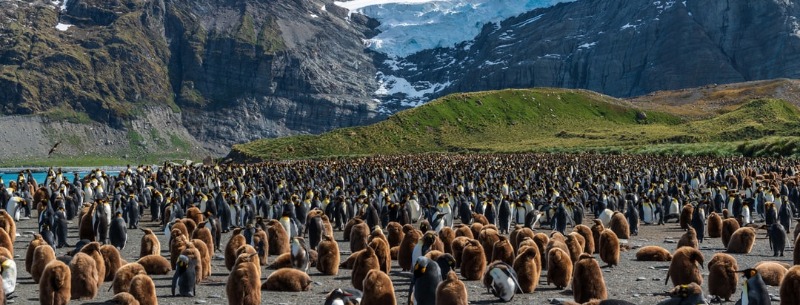Grytviken, capital city of South Georgia
South Georgia and the South Sandwich Islands are true jewels. The sub-Antarctic islands are blessed with rich histories, huge glaciers and a wealth of wildlife. From 1904 through 1965, a whaling station operated at Grytviken. It was the first on the island, the longest-running and the only station that can be visited today.
It only took about 20 minutes to butcher a whale, but the islanders found keeping pace with the catcher’s vessels a challenge. Up to four dozen whales could arrive at once, leaving Grytviken Bay blanketed in carcasses. To keep them afloat, the whalers pumped the carcasses with compressed air.
The crime rate at Grytviken was low, and illegal alcohol production was the biggest issue on the island, but the jail was most often used as an inn for visiting expeditions.
In 1992, the former station manager’s home was transformed into the South Georgia Museum. As you enter the wonderful museum, look up so you do not miss the mounted albatross that soar across the ceiling. Unless you happen to be a scientist, this is the nearest you will ever come to one of the magnificent creatures.
Fascinating exhibits fill the museum, highlighting the islands’ wildlife and history. The shop is also abundant with interesting treasures, including patches, postcards, books, clothing and slide sets.
The restored Whalers’ Church at Grytviken is an incredible example of traditional Norwegian architecture. Originally built in Strommen, the entire church was completely dismantled and sent to Grytviken in 1913. Inside is a moving memorial to Carl Anton Larsen, the founder of Grytviken, and visitors are welcome to explore the upper floors and ring the two bells.
The city’s cinema once stood next to the church, but it was destroyed by a storm in 1994. In 2002, the remains were removed, and the projector and signboard are on display in the South Georgia Museum.
The highlight of the beautiful whalers’ cemetery is the grave of Sir Ernest Shackleton, the Anglo-Irish explorer who died in Grytviken in 1922. Known to other explorers as “the boss,” Shakleton is buried in the graveyard’s rear left corner. His granite headstone is engraved with his personal emblem, a nine-pointed star, and a quotation from Robert Browning, one of his favorite poets.
Sixty-three other graves surround Shackleton, including those of numerous 19th-century sealers. The majority belong to Norwegian whalers, including those who perished in a typhus epidemic in 1912. One holds the remains of a soldier from Argentina killed in the Falklands War.
Sunshine-yellow dandelions blanket the cemetery. The seeds were originally imported from Norway so the dead whalers could be buried in a space connected to their homeland.
The hillside above the cemetery is crowned with a cross commemorating Walter Slossarczyk, a German explorer who sought to map out Antarctica in 1911. During the expedition, Slossarczyk rowed away from the ship the Deutschland in a dinghy and never returned. Three days later, his body was found near Grytviken.
The other cross that marks the hillside is dedicated to 17 men who perished when their fishing boat sank just off the shores of Grytviken in 1998.
The area around Grytviken is rich in animal life. Fin whales swim off the shores, reindeer herds traipse through the forests and Weddell seals gather on the icebergs near the coast. The government of the South Georgia Islands is committed to maintaining the natural environment that hosts these and other creatures, and they work with many other conservation departments to ensure the natural habitats are protected.
